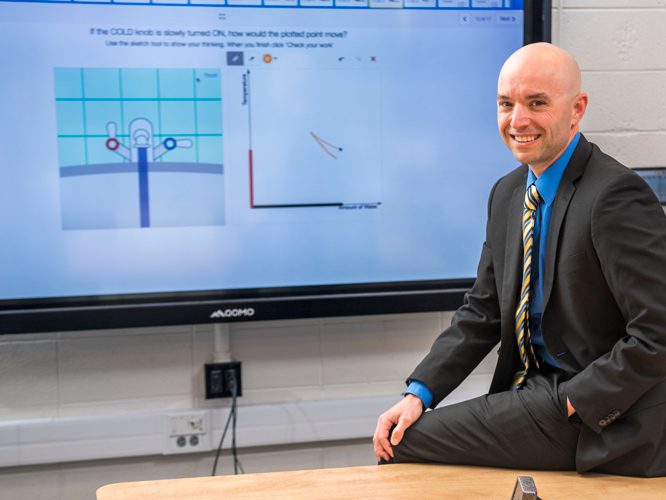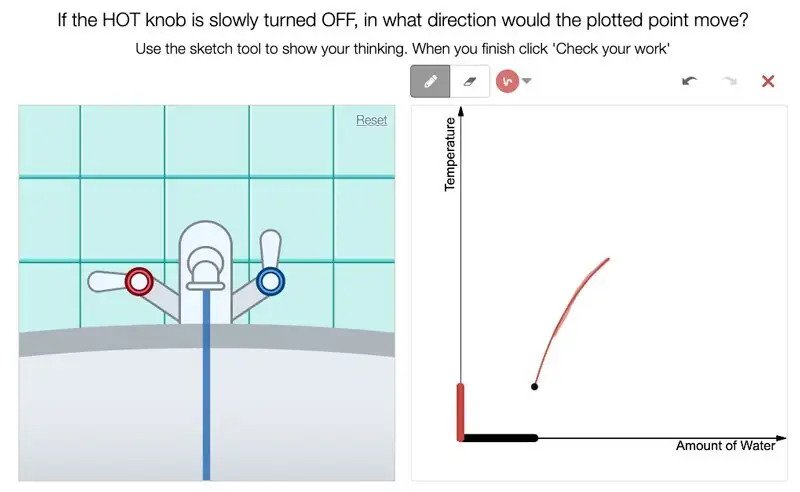A Novel Approach to Teaching Algebra

UD’s Teo Paoletti receives NSF CAREER award to help students develop reasoning skills with digital tools
Unlike other elementary and middle school mathematics courses, algebra begins to introduce abstract relationships and ideas. While textbooks attempt to give students real-world illustrations of these new concepts, many students struggle to match what they’re learning in the classroom with concrete experiences.
For students who struggle to master these foundational concepts, the challenges of algebra can have long-term economic and social impacts. Algebra often serves as a gatekeeper for future mathematics coursework and careers in science, technology, engineering and mathematics (STEM). How can K-12 educators support their students in developing this critical algebraic knowledge?
The University of Delaware’s Teo Paoletti, who is an assistant professor in the College of Education and Human Development’s (CEHD) School of Education (SOE), said he thinks that the answer might lie in helping students develop covariational reasoning or the ability to reason about relationships as quantities change together. He has received a considerable funding award from the National Science Foundation (NSF) that may help further his investigation. Through the Covariational and Algebraic Reasoning Project: A New Path to Algebra (Project CARe), Paoletti will create and test digital instructional tasks designed to support middle schoolers’ covariational reasoning using a free educational technology platform. He hopes to integrate education and research to create a new path into learning algebra for middle school students.
In support of this novel approach to teaching and learning algebra, Paoletti received a nearly $885,000 NSF CAREER award, one of the organization’s most prestigious awards. These awards support early-career faculty who have the potential to serve as academic role models in research and education and to lead advances in the mission of their organization.
“Part of what makes school algebra so difficult for students is that it can feel really abstract and different from what they experience in their day-to-day life,” Paoletti said. “When learning how to add, subtract, multiply and divide numbers, students have concrete experiences that they can draw on. However, algebra is more complex than arithmetic. By designing opportunities for students to see and experience quantities changing in context, they can begin to represent relationships between these changing quantities. My goal is for students to see how they can use graphs and algebraic expressions as representations of the concrete relationships they conceive of in a situation. This approach can not only provide a more accessible entry way into algebra, but also better connects with how algebra is used in science and engineering fields.”
What is Project CARe?
In Project CARe, Paoletti will explore how middle schoolers’ ability to reason covariationally might help them develop an understanding of ideas that are critical to learning algebra. Specifically, he will investigate how students’ covariational reasoning may serve as a foundation for the development of algebraic reasoning and identify the instructional paths — or what teachers can do in the classroom — for supporting their reasoning.
A series of novel, digital instructional tasks, designed and piloted by Paoletti, serves as the basis of this project. Using the free, publicly available Desmos platform, Paoletti will create a research-based sequence of instructional activities, including teacher support materials, that have been effective in supporting students’ algebraic and covariational reasoning.
For example, the Faucet Task, which asks students to make predictions about water flow and temperature changes as they adjust the hot and cold knobs on a digital faucet, is designed to help students develop understandings for graphing. After playing with the knobs and observing animated changes in flow and temperature (indicated by color changes), students are asked to make predictions about how specific actions — like turning on the cold knob slowly — will affect the water flow and temperature. Students then practice graphing these relationships.

“By using dynamic digital applets, students have concrete opportunities to explore how quantities are changing,” Paoletti said. “Although algebra textbooks try to give students opportunities to think about real-world scenarios, many times a written word problem with a static picture isn’t enough. Students need to really understand the context, the quantities in the context and how they are changing for algebraic representations to make sense. Dynamic applets can bring quantities to life for students, which can help them understand relationships between them. Such opportunities are necessary for students to understand algebra as a tool to represent relationships between changing quantities.”
Other activities include the Growing Triangle Task, which helps students further develop their graphing understanding, and the Growing Triangle/Rectangle Task, which helps students differentiate between linear and non-linear change.
Through small-group and whole-class explorations with these digital tasks, Paoletti will study how individual students build their algebraic knowledge through covariational reasoning.
Supporting K-12 mathematics educators
By the end of this five-year project, Paoletti said he hopes to develop tasks that teachers can use to support their own students’ covariational reasoning and algebra learning.
“In the end, my goal is to design tasks that algebra and pre-algebra teachers are excited to use in their own classrooms because they see the potential for their students to develop understandings they’ll need as they journey through algebra,” Paoletti said. “The tasks will be flexible enough so that they could be used in sequence at the outset of an algebra course or could be integrated at strategic times throughout an entire algebra course as students begin to learn about particular topics such as linear or quadratic relationships. Further, by designing the tasks in the Desmos environment, which many math teachers are already using, any teacher can quickly implement (and even adapt) the tasks I create with their own students.”
Paoletti is the third member of the School of Education to receive an NSF CAREER award. In 2017, Charles Hohensee, associate professor in the SOE, received the award to study student learning and backward transfer in mathematics. In 2019, Teomara Rutherford, assistant professor in the SOE, received the award to study the link between motivation and mathematics achievement within a digital context.
To learn more about research in STEM Education, visit CEHD’s STEM Education research page.
Photo by Kathy F. Atkinson | Illustration courtesy of Teo Paoletti



